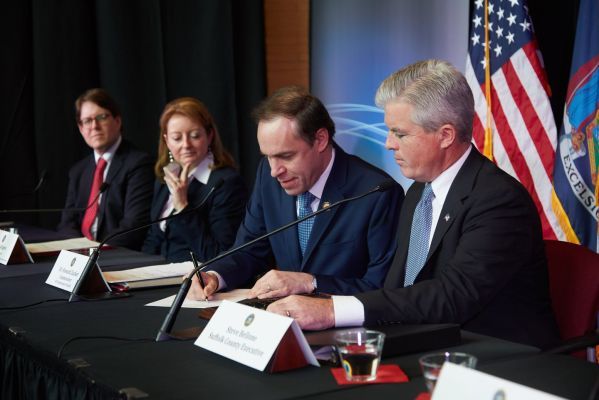EPA Needs to Set Drinking Water Standard for 1,4-dioxane
Published on by Water Network Research, Official research team of The Water Network in Government
Gov. Andrew M. Cuomo and state and Suffolk County officials pressed the EPA to set a drinking water standard for 1,4-dioxane.

From left, Dr. Harold Walker, co-director of the Stony Brook Center for Clean Water Technology, Carrie Gallagher, regional director for the state Department of Environmental Conservation, with state Health Commissioner Dr. Howard Zucker as he signs a letter to the EPA. Suffolk County Executive Steve Bellone is at right. They were at a meeting on water quality issues at Stony Brook University Feb. 11, 2017. Photo Credit: Ed Betz
The state Department of Environmental Conservation said it will expand New York’s Superfund program to require that all hazardous waste sites be evaluated for the man-made chemical, a manufacturing solvent that is also found in detergents, shampoos, deodorants and other products.
The announcement came after state officials, politicians, activists, and water industry professionals met at Stony Brook University’s Center for Clean Water Technology. Several of those in attendance co-signed a letter Cuomo wrote to acting EPA Administrator Catherine McCabe, asking her to regulate 1,4-dioxane nationally and invest in treatment technology.
State Health Commissioner Howard Zucker said New York will give the EPA about three months to respond before moving to set its own safe drinking water standard.
“This is a national issue and the federal government needs to step up and provide clear guidance to states on how to address 1,4-dioxane,” Cuomo said in a statement to Newsday. “If they don’t act, we will.”
Every five years the EPA selects up to 30 unregulated contaminants for suppliers to test for in order to get a picture of how prevalent they may be and at what concentrations. It’s one way the federal agency decides whether to set a drinking water standard.
Last month, Newsday reported that 1,4-dioxane had been found in 71 percent of water districts sampled on Long Island at a level that poses a one-in-a-million cancer risk after a lifetime of prolonged exposure, according to the EPA data.
Nationwide, the same risk was reported in only 7 percent of water supplies tested as part of an EPA survey of all large suppliers and a sampling of smaller suppliers.
The state Department of Environmental Conservation said it will expand New York’s Superfund program to require that all hazardous waste sites be evaluated for the man-made chemical, a manufacturing solvent that is also found in detergents, shampoos, deodorants and other products.
Source: Newsday
Media
Taxonomy
- Water Law
- Contaminant Removal
- Water Supply
- Water Supply
- Pollution
- Public Health
- Laboratory Testing
- Contaminant Control